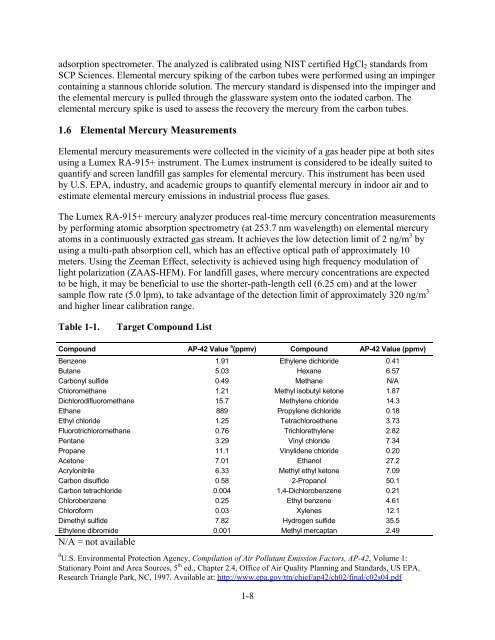Quantifying Uncontrolled Landfill Gas Emissions from Two Florida ...
Quantifying Uncontrolled Landfill Gas Emissions from Two Florida ...
Quantifying Uncontrolled Landfill Gas Emissions from Two Florida ...
You also want an ePaper? Increase the reach of your titles
YUMPU automatically turns print PDFs into web optimized ePapers that Google loves.
adsorption spectrometer. The analyzed is calibrated using NIST certified HgCl2 standards <strong>from</strong><br />
SCP Sciences. Elemental mercury spiking of the carbon tubes were performed using an impinger<br />
containing a stannous chloride solution. The mercury standard is dispensed into the impinger and<br />
the elemental mercury is pulled through the glassware system onto the iodated carbon. The<br />
elemental mercury spike is used to assess the recovery the mercury <strong>from</strong> the carbon tubes.<br />
1.6 Elemental Mercury Measurements<br />
Elemental mercury measurements were collected in the vicinity of a gas header pipe at both sites<br />
using a Lumex RA-915+ instrument. The Lumex instrument is considered to be ideally suited to<br />
quantify and screen landfill gas samples for elemental mercury. This instrument has been used<br />
by U.S. EPA, industry, and academic groups to quantify elemental mercury in indoor air and to<br />
estimate elemental mercury emissions in industrial process flue gases.<br />
The Lumex RA-915+ mercury analyzer produces real-time mercury concentration measurements<br />
by performing atomic absorption spectrometry (at 253.7 nm wavelength) on elemental mercury<br />
atoms in a continuously extracted gas stream. It achieves the low detection limit of 2 ng/m 3 by<br />
using a multi-path absorption cell, which has an effective optical path of approximately 10<br />
meters. Using the Zeeman Effect, selectivity is achieved using high frequency modulation of<br />
light polarization (ZAAS-HFM). For landfill gases, where mercury concentrations are expected<br />
to be high, it may be beneficial to use the shorter-path-length cell (6.25 cm) and at the lower<br />
sample flow rate (5.0 lpm), to take advantage of the detection limit of approximately 320 ng/m 3<br />
and higher linear calibration range.<br />
Table 1-1. Target Compound List<br />
Compound AP-42 Value a (ppmv) Compound AP-42 Value (ppmv)<br />
Benzene 1.91 Ethylene dichloride 0.41<br />
Butane 5.03 Hexane 6.57<br />
Carbonyl sulfide 0.49 Methane N/A<br />
Chloromethane 1.21 Methyl isobutyl ketone 1.87<br />
Dichlorodifluoromethane 15.7 Methylene chloride 14.3<br />
Ethane 889 Propylene dichloride 0.18<br />
Ethyl chloride 1.25 Tetrachloroethene 3.73<br />
Fluorotrichloromethane 0.76 Trichlorethylene 2.82<br />
Pentane 3.29 Vinyl chloride 7.34<br />
Propane 11.1 Vinylidene chloride 0.20<br />
Acetone 7.01 Ethanol 27.2<br />
Acrylonitrile 6.33 Methyl ethyl ketone 7.09<br />
Carbon disulfide 0.58 2-Propanol 50.1<br />
Carbon tetrachloride 0.004 1,4-Dichlorobenzene 0.21<br />
Chlorobenzene 0.25 Ethyl benzene 4.61<br />
Chloroform 0.03 Xylenes 12.1<br />
Dimethyl sulfide 7.82 Hydrogen sulfide 35.5<br />
Ethylene dibromide<br />
N/A = not available<br />
0.001 Methyl mercaptan 2.49<br />
a<br />
U.S. Environmental Protection Agency, Compilation of Air Pollutant Emission Factors, AP-42, Volume 1:<br />
Stationary Point and Area Sources, 5 th ed., Chapter 2.4, Office of Air Quality Planning and Standards, US EPA,<br />
Research Triangle Park, NC, 1997. Available at: http://www.epa.gov/ttn/chief/ap42/ch02/final/c02s04.pdf<br />
1-8















